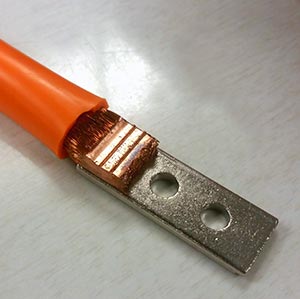
Sonobond Ultrasonics’ Battery Assembly Capabilities Expand to China
Ultrasonic Dual Head Welder Achieves High-Strength Welding of High Voltage Terminals without Causing Fracturing
WEST CHESTER, Pennsylvania, May 17, 2018—Automotive component manufacturers now have a reliable, environmentally friendly and cost-effective solution for assembling high voltage terminals used for storage in electric and hybrid vehicles.
Sonobond Ultrasonics’ Dual Head Spot Welder, equipped with special tooling, can weld heavy wires up to 80 sq. mm. cross sectional area without fracturing the terminal. Additionally, it achieves a higher-strength weld using lower power than other ultrasonic welders, and a more durable weld than crimp or solder methods.
“With current and future models of electric, fuel cell, hybrid and plug-in hybrid vehicles expected to claim a greater share of the automotive market, the need for high voltage electrical terminals, especially for storage, is likely to increase,” says Janet Devine, president, Sonobond Ultrasonics. “Our Dual Head Spot Welder with custom tooling is well positioned to help component manufacturers meet growing demand.”
Designing an Assembly Solution
As an example, Devine notes that a leading international automotive component manufacturer was getting a high percentage of cracked terminals when using a competitor’s 5000-watt ultrasonic welder for assembly. The damaged terminals had to be scrapped.
“By using our 3500-watt Ultrasonic Dual Head Spot Welder, equipped with custom tooling we designed for their specific application, Sonobond enabled the company to make high strength and durable welds with no cracked terminals,” Devine explains. “To meet the company’s needs, we took a step-by-step approach, considering the geometry and specifications of the finished product, and then creating tooling to hold the wires in the proper orientation while welding, but without unnecessarily complicating the load and unload operations.”
Advantages of Sonobond Ultrasonic Technology
Sonobond’s ultrasonic metal welders require no external heat, fluxes or fillers and produce no arcs, sparks or flames. Instead, welding occurs by employing the company’s unique, patented Wedge-Reed ultrasonic bonding system that combines high vibratory force and low-amplitude coupling. Shear mode vibration is applied parallel to the welding surface, while the line of force is directly over the parts to be welded. This eliminates bending stress and creates consistent, solid-state, highly conductive, metallurgical welds. It also provides the unique ability to weld lightly tinned and oxidized non-ferrous metals, even without pre-cleaning.
Distinctive Features of the Dual Head Spot Welder
The Dual Head Spot Welder is the first ultrasonic welder to join up to 100 layers of copper or aluminum foil to battery terminals without tearing and in just one pulse, along with its capacity to weld wire bundles up to 80 sq. mm. cross sectional area to terminals. It has a digital display that allows weld control by time, energy or (optional) distance. Additionally, the unit has a power supply with a built in microprocessor, featuring automatic frequency overload protection, and storage and recall of up to 250 protocols. Sonobond’s Dual Head Spot Welder also comes equipped with heat-treated tool steel Taper Lock Tips. They can perform up to 30,000 welds before redressing and as many as 100,000 welds before replacement.
Metal Welding Viability Test Without Obligation
Sonobond conducts a free, no-obligation metal welding viability test for all potential customers to ensure that ultrasonic welding technology is a good fit and to choose the welder best suited to handle their specific part configuration. This gives Sonobond technicians an opportunity to recommend the best equipment for the job and show outcomes to customers.
Companies may arrange for an ultrasonic metal welding viability test, and completing a short form with their basic information so that a free test can be scheduled.
“We respond promptly to requests,” says Devine. “If an application seems feasible, we let the company know the amount of material needed for sample welds and discuss the details of their requirements for the completed weld. Once everything is in place, the test can be completed in about a week, provided no custom tooling is required to make a sample weld.” She adds, “Having customers provide their own similar or dissimilar non-ferrous materials for the viability test enables them to see actual results before they purchase the equipment.”
Before shipping, completed sample welds are checked to make certain we can meet customers’ dimensional tolerances, as well as electrical and mechanical requirements. Customers are invited to review the welding operation or receive sample welds to compare to their specifications. “In most cases, we have one of our technicians present at the customer’s site for set up and operations approval,” notes Devine.
Increasing Variety of Ultrasonic Metal Welding Applications
Sonobond Ultrasonics produces a complete line of ultrasonic metal welders that are utilized in an expanding variety of applications including, electrical wire harnesses, bus bars, lithium-ion batteries, foil-wound capacitors, joining thin aluminum or copper foil, fuses/circuit breakers, ignition modules, starter motors, and photovoltaic panel interconnects, among others. All welding units are made in the U.S. and require minimal operator training.
A Proven Leader in Ultrasonic Welding and Bonding Technology
Sonobond has earned worldwide recognition for its leadership and innovations in ultrasonic bonding and welding. In 1960, the company—then known as Aeroprojects—received the first patent ever awarded for ultrasonic metal welding. In subsequent years, Sonobond’s reputation for pioneering quality-engineered products has grown. Today, leading companies in the electrical, automotive, appliance, solar, aerospace, filtration, medical, body armor and apparel industries use Sonobond’s ultrasonic bonding and welding units.
